August 17, 1806 - the sloop "Neva" under the command of Yuri Lisyansky anchored in the Kronstadt roadstead, completing the first Russian circumnavigation, which lasted a little over three years. By order of Alexander I, a special medal was issued for all participants in the journey.
On August 7, 1803, two ships set out on a long voyage from Kronstadt. These were the ships "Nadezhda" and "Neva", on which Russian sailors were to make a round-the-world trip.
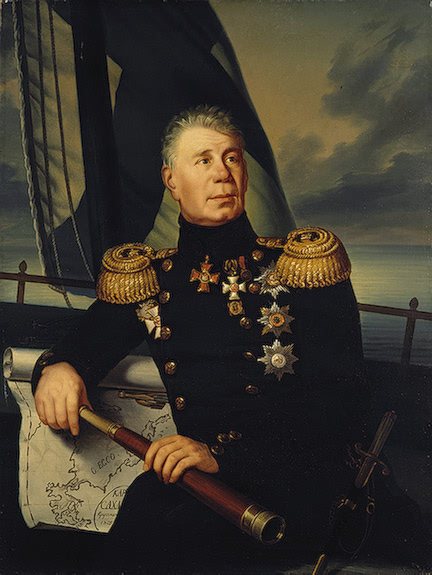
Ivan Fyodorovich Kruzenshtern
Kruzenshtern project
The head of the expedition was Captain-Lieutenant Ivan Fedorovich Kruzenshtern, the commander of the Nadezhda. The Neva was commanded by Lieutenant Commander Yuri Fedorovich Lisyansky. Both were experienced sailors who had already taken part in long-distance voyages. Kruzenshtern improved his skills in maritime affairs in England, took part in the Anglo-French war, was in America, India, and China. During his travels, Kruzenshtern came up with a bold project, the implementation of which was intended to promote the expansion of Russian trade relations with China. It consisted in the fact that instead of a difficult and long journey by land, to establish communication with the American possessions of the Russians (Alaska) by sea. On the other hand, Kruzenshtern suggested a closer point for selling furs, namely China, where furs were in great demand and were valued very dearly. To implement the project, it was necessary to undertake a long journey and explore this new path for the Russians.
After reading Kruzenshtern's draft, Paul I muttered: "What nonsense!" - and that was enough for a bold undertaking to be buried for several years in the affairs of the Naval Department. Under Alexander I, Krusenstern again began to achieve his goal. He was helped by the fact that Alexander himself had shares in the Russian-American Company. The travel plan has been approved.
preparations
It was necessary to purchase ships, since there were no ships suitable for long-distance navigation in Russia. The ships were bought in London. Kruzenshtern knew that the trip would give a lot of new things for science, so he invited several scientists and the painter Kurlyandtsev to participate in the expedition.
The expedition was comparatively well equipped with precise instruments for conducting various observations, had a large collection of books, nautical charts and other manuals necessary for long-distance navigation.
Kruzenshtern was advised to take English sailors on the voyage, but he protested vigorously, and the Russian team was recruited. Krusenstern paid special attention to the preparation and equipment of the expedition. Both equipment for sailors and individual, mainly antiscorbutic, food products were purchased by Lisyansky in England.
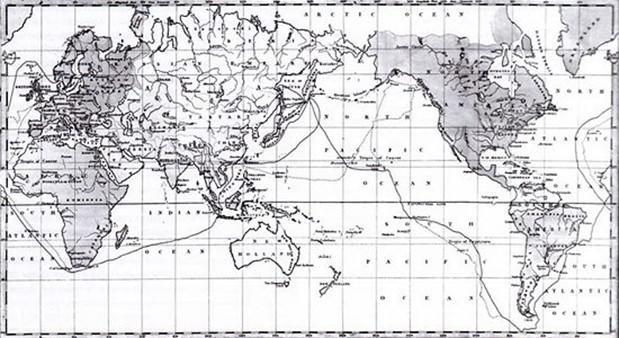
Map of the first Russian round-the-world trip
Having approved the expedition, the king decided to use it to send an ambassador to Japan. The embassy had to repeat the attempt to establish relations with Japan, which at that time was almost completely unknown to the Russians. Japan traded only with Holland, for other countries its ports remained closed. In addition to gifts to the Japanese emperor, the embassy mission was supposed to take home several Japanese who accidentally ended up in Russia after a shipwreck and lived there for quite a long time.
Sailing to Cape Horn.
The first stop was in Copenhagen, where instruments were checked at the observatory. Departing from the coast of Denmark, the ships headed for the English port of Falmouth. While staying in England, the expedition acquired additional astronomical instruments.
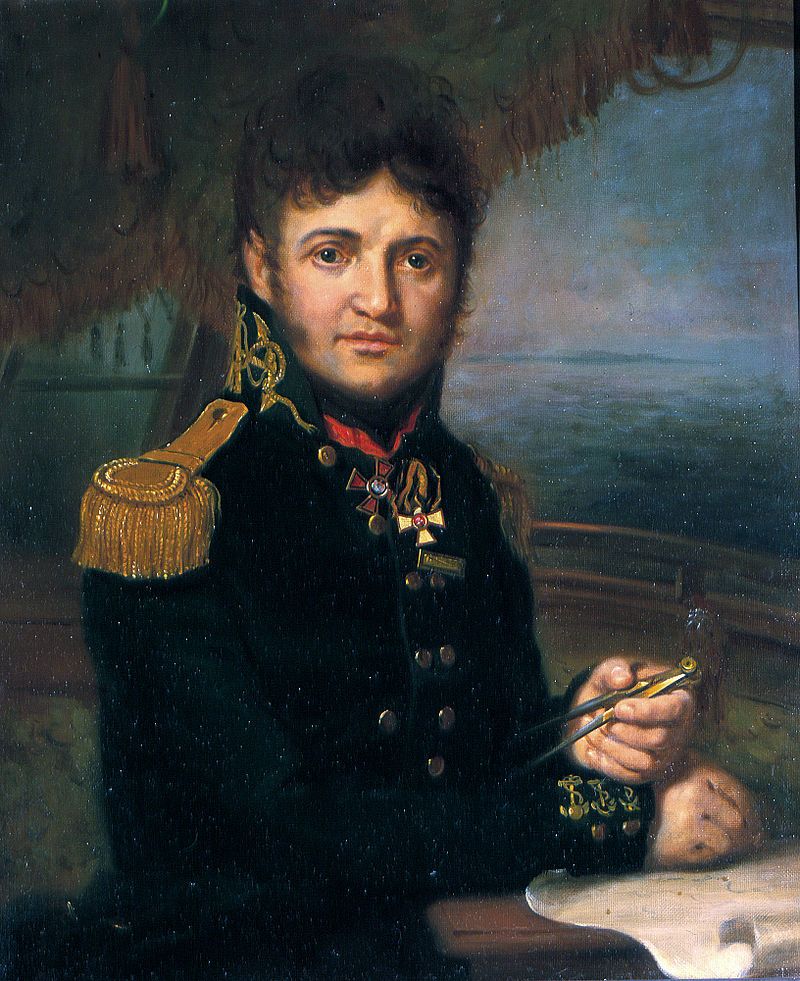
Yuri Fedorovich Lisyansky
From England, the ships headed south along the eastern shore of the Atlantic Ocean. October 20 "Nadezhda" and "Neva" were on the roadstead of the small Spanish city of Santa Cruz, located on the island of Tenerife. The expedition stocked up on food, fresh water, and wine. Sailors, walking around the city, saw the poverty of the population and witnessed the arbitrariness of the Inquisition. In his notes, Kruzenshtern noted: “It is terrible for a free-thinking person to live in such a world where the anger of the Inquisition and the unlimited autocracy of the governor operate in full force, disposing of the life and death of every citizen.”
Leaving Tenerife, the expedition headed for the shores of South America. During the voyage, scientists conducted a study of the temperature of different layers of water. An interesting phenomenon was noticed, the so-called "glow of the sea". A member of the expedition, the naturalist Tilesius established that the light was given by the smallest organisms, which were in abundance in the water. Carefully filtered water ceased to glow.
On November 23, 1803, the ships crossed the equator, and on December 21 they entered the Portuguese possessions, which at that time included Brazil, and anchored off Catherine Island. The mast needed to be repaired. The stop made it possible to conduct astronomical observations in the observatory installed on the shore. Kruzenshtern notes the great natural wealth of the region, in particular, tree species. It has up to 80 samples of valuable tree species that could be traded. Off the coast of Brazil, observations were made of the tides, the direction of sea currents, and water temperatures at various depths.
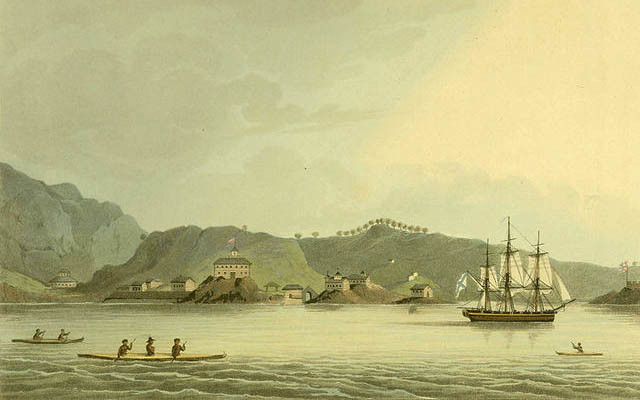
Sloop "Hope" off the coast of South America
To the shores of Kamchatka and Japan
Near Cape Horn, due to stormy weather, the ships were forced to separate. The meeting point was set at Easter Island or Nukagiva Island. Safely rounding Cape Horn, Kruzenshtern headed for Nukagiva Island and anchored in the port of Anna Maria. The sailors met two Europeans on the island - an Englishman and a Frenchman, who lived with the islanders for several years. The islanders brought coconuts, breadfruit and bananas in exchange for old metal hoops. Russian sailors visited the island. Kruzenshtern gives a description of the appearance of the islanders, their tattoos, jewelry, dwellings, dwells on the characteristics of life and social relations. The Neva came to Nukagiva Island late, as Lisyansky was looking for the Nadezhda near Easter Island. Lisyansky also reports a number of interesting information about the population of Easter Island, the clothes of the inhabitants, dwellings, gives a description of the wonderful monuments erected on the shore, which La Perouse mentioned in his notes.
After sailing from the shores of The Nukagiva expedition headed for the Hawaiian Islands. There, Kruzenshtern planned to stock up on food, especially fresh meat, which the sailors had not had for a long time. However, what Kruzenshtern offered to the islanders in exchange did not satisfy them, since the ships that landed on the Hawaiian Islands often brought European goods here.
The Hawaiian Islands were the point of travel where the ships had to separate. From here, the path of the Nadezhda went to Kamchatka and then to Japan, and the Neva was supposed to follow to the northwestern shores of America. The meeting was scheduled in China, in the small Portuguese port of Macau, where the purchased furs were to be sold. The ships parted.
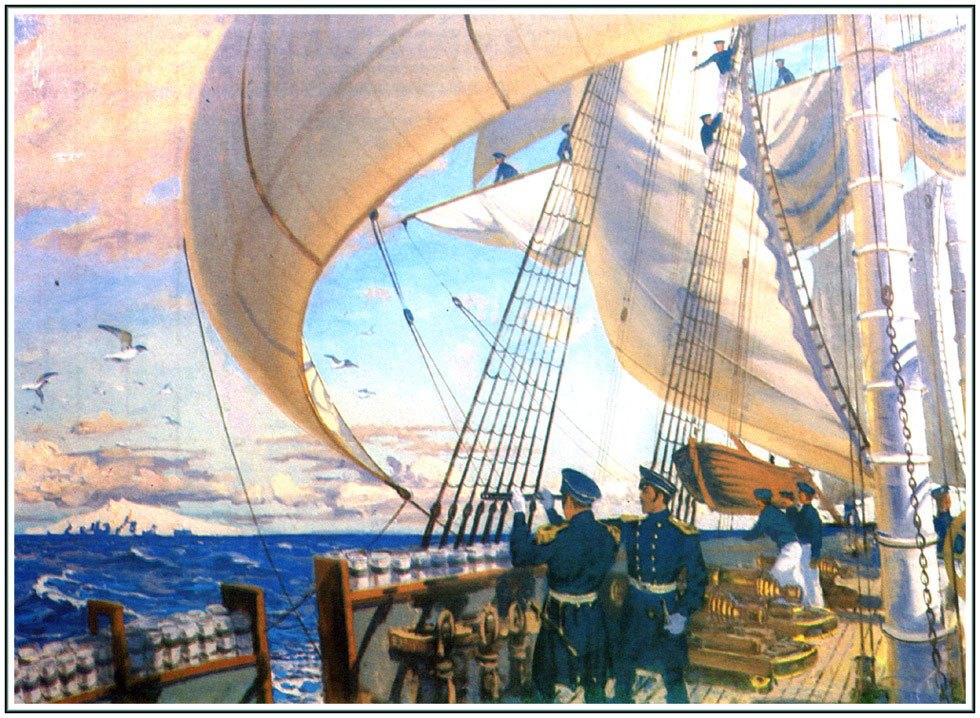
Sloop "Hope"
July 14, 1804 "Nadezhda" entered the Avacha Bay and anchored off the city of Petropavlovsk. In Petropavlovsk, the goods brought for Kamchatka were unloaded, and the ship's gear, which had worn out during a long journey, was repaired. In Kamchatka, the main food of the expedition was fresh fish, which, however, could not be stocked up for further sailing due to the high cost and lack of the required amount of salt.
On August 30, Nadezhda left Petropavlovsk and headed for Japan. Almost a month has passed in swimming. On September 28, the sailors saw the shores of the island of Kiu-Siu (Kyu-Su). Heading to the port of Nagasaki, Kruzenshtern explored the Japanese coast, which has many bays and islands. He was able to establish that on the sea charts of that time, in a number of cases, the shores of Yaponka were plotted incorrectly.
Dropping anchor in Nagasaki, Kruzenshtern informed the local governor of the arrival of the Russian ambassador. However, the sailors were not allowed to go ashore. The issue of receiving the ambassador was to be decided by the emperor himself, who lived in Ieddo, so he had to wait. Only after 1.5 months, the governor allocated a certain place on the shore, surrounded by a fence, where the sailors could walk. Even later, after repeated appeals from Krusenstern, the governor set aside a house for the ambassador on the shore.
Only on March 30 did a representative of the emperor arrive in Nagasaki, who was instructed to negotiate with the ambassador. During the second meeting, the commissioner said that the Japanese emperor had refused to sign a trade treaty with Russia and that Russian ships were not allowed to enter Japanese ports. The Japanese, brought to their homeland, nevertheless, finally got the opportunity to leave the Nadezhda.
Back to Petropavlovsk
From Japan, Nadezhda headed back to Kamchatka. Kruzenshtern decided to return by another route - along the western coast of Japan, almost unexplored at that time by Europeans. The Nadezhda sailed along the coast of Nipon Island (Hopshu), explored the Sangar Strait, and passed the western coast of Iesso Island (Hokkaido). Having reached the northern tip of Iesso, Kruzenshtern saw the Ainu, also living in the southern part of Sakhalin. In his notes, he gives a description of the physical appearance of the Ainu, their clothes, dwellings, and occupations.
Following further, Kruzenshtern carefully explored the shores of Sakhalin. However, he was prevented from continuing his journey to the northern tip of Sakhalin by the accumulation of ice. Krusenstern decided to go to Petropavlovsk. In Petropavlovsk, the ambassador with the naturalist Langsdorf left the Nadezhda, and after a while Kruzenshtern went to continue exploring the shores of Sakhalin. Having reached the northern tip of the island, Nadezhda rounded Sakhalin and went along its western coast. In view of the fact that the deadline for departure to China was approaching, Kruzenshtern decided to return to Petropavlovsk in order to better prepare for this second part of the voyage.
From Petropavlovsk, Kruzenshtern sent maps and drawings drawn up during the trip to St. Petersburg so that they would not be lost in the event of an accident that could happen during the return voyage.
“The shores of Petropavlovsk,” writes Kruzenshtern, “are covered with scattered stinking fish, over which hungry dogs gnaw for rotting remains, which is an extremely disgusting view. Upon reaching the shore, you will look in vain for the roads that have been made, or even for any convenient path leading to the city, in which you do not find a single well-built house ... Near it there is not a single verdant good plain, not a single garden, not a single decent vegetable garden, which would show traces of cultivation. We only saw 10 cows grazing between the cabins.”
Such was then Petropavlovsk-Kamchatsky. Kruzenshtern points out that the supply of bread and salt almost did not provide the population. Krusenstern left the salt and cereals received as a gift in Japan for the population of Kamchatka.
The population of Kamchatka also suffered from scurvy. Medical assistance was almost non-existent, there were not enough medicines. Describing the disastrous condition of the inhabitants of Kamchatka, Kruzenshtern pointed out the need to improve the supply and the possibility of developing agriculture there. He especially noted the extremely difficult situation of the native population - the Kamchadals, who were robbed and drunk with vodka by Russian fur buyers.
Swimming in China
Having completed the necessary work to repair the rigging and renewed the food supply, Kruzenshtern went to China. The weather interfered with routine surveys to locate the island. In addition, Krusenstern was in a hurry to arrive in China.
On a stormy night, the Nadezhda passed through the strait near the island of Formosa and on November 20 anchored in the port of Macau. At the time when Kruzenshtern traveled with the ambassador to Japan and explored the shores of Japan, Sakhalin and Kamchatka, the Neva visited the Kodiak and Sitkha islands, where the possessions of the Russian-American Company were located. Lisyansky brought the necessary supplies there and then set sail along the coast of the northwestern part of America.
Lisyansky wrote down a large amount of information about the Indians and collected a whole collection of their household items. The Neva spent almost a year and a half off the coast of America. Lisyansky was late for the meeting scheduled by Kruzenshtern, but the Neva was loaded to capacity with valuable furs that had to be transported to China.
Upon arrival in Macau, Kruzenshtern learned that the Neva had not yet arrived. He informed the governor of the purpose of his arrival, but before the arrival of the Neva, Nadezhda was asked to leave Macau, where military courts were forbidden to stay. However, Kruzenzenshtern managed to persuade the local authorities, assuring them that the Neva would soon arrive with a valuable cargo that was of interest to Chinese trade.
The Neva arrived on December 3 with a large load of furs. However, it was not immediately possible to ask permission for both ships to enter the harbor near Canton, and Krusenstern went there together with Lisyansky on the Neva. Only after intense efforts did Kruzenshtern receive this permission, promising to buy a large amount of Chinese goods.
Significant difficulties were also encountered in the sale of furs, since Chinese merchants did not dare to enter into trade relations with the Russians, not knowing how the Chinese government would look at it. However, Kruzenshtern, through a local English trading office, managed to find a Chinese merchant who bought the imported cargo. Having shipped the furs, the Russians began loading tea and other purchased Chinese goods, but at that time their export was prohibited until permission was obtained from Beijing. Again, it took a long time to get this permission.
Homecoming. Expedition results.
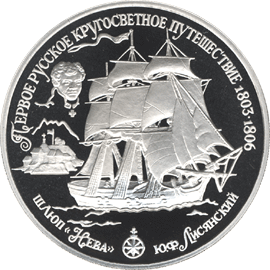
Coin "Sloop" Neva "
Kruzenshtern's expedition made the first attempt to establish maritime trade relations with China - before that, Russian trade with China was carried out by land. Kruzenshtern in his notes described the state of the then Chinese trade and indicated the ways in which trade with the Russians could develop. February 9, 1806 "Nadezhda" and "Neva" left Canton and headed back to their homeland. This route lay across the Indian Ocean, past the Cape of Good Hope and further along the route well known to Europeans. August 17, 1806 "Nadezhda" approached Kronstadt. The Neva was already there, having arrived a little earlier. The journey, which had lasted three years, was over. The journey of Kruzenshtern and Lisyansky gave a lot of new things for the knowledge of a number of areas of the globe. The studies carried out enriched science, valuable material was collected, necessary for the development of navigation. During the voyage, astronomical and meteorological observations were systematically made, the temperature of different layers of water was determined, and depth measurements were made. During the long stay in Nagasaki, observations were made of the tides, the Expedition carried out work on compiling new maps and checking old ones. Dr. Tilesius compiled a large atlas illustrating the nature and population of the countries visited.
Extraordinarily interesting are household items brought by the expedition from the Pacific Islands and North America. These things were transferred to the Museum of Ethnography of the Academy of Sciences. The notes of Kruzenshtern and Lisyansky were published. The round-the-world trip on the "Nadezhda" and "Neva" wrote a glorious page in the history of Russian navigation.
Based on materials: http://azbukivedi-istoria.ru/
